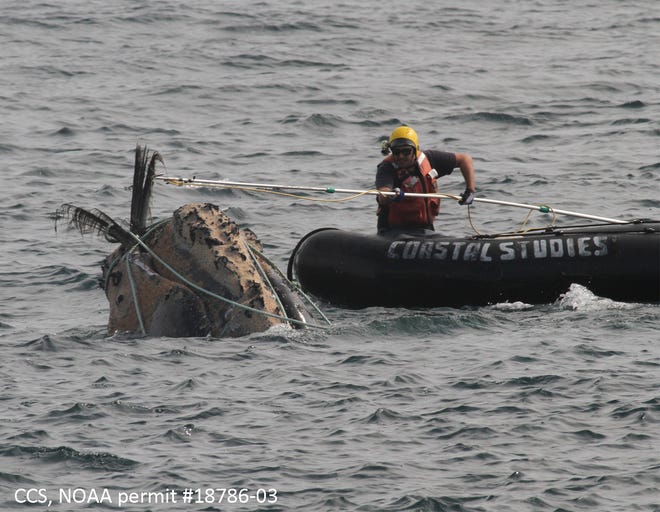Feds release plan to better prevent right whale deaths by entanglement
The National Ocean and Atmospheric Administration released a much-anticipated plan on Wednesday that it says will reduce North Atlantic right whale mortalities from entanglement in fishing gear by 60%.
The right whale is the most endangered great whale on the planet, with around 360 individuals remaining, including less than 100 breeding-age females.
The new plan achieves the 60% mortality reduction through new seasonally closed areas, increases in the number of pots connected to a buoy line and requirements to add more weak links that allow a whale to break vertical lines and hopefully shed lines and pots.
NOAA’s plan also proposes a more rigorous gear-marking system it hopes will make it possible to identify the fishery management area for fishing line found on entangled whales. That would allow for more precise targeting of problem areas.
New closures include an area south of Nantucket where right whales are congregating year-round but had been subject only to voluntary speed reductions.
NOAA will be holding public hearings on the draft environmental impact statement for the new whale plan, and public comments will be taken until March 1, with an eye toward having new regulations in place for the beginning of the new fishing year on May 1.

The North Atlantic population size has been lower, with an estimated 270 individuals in 1990. The population rebounded to 481 by 2011.
Since then, however, the species has been in decline. Recently, as right whales have migrated into new territory in Canada in search of food, the number of dead right whales caught in fishing gear or hit by vessels has shot up. Particularly hard hit were females, leading some researchers to worry that the species could reach functional extinction — too few females to rebuild the species — within a decade or two.
Scientists have determined that less than one right whale per year, on average, can die of human-induced causes. But that number has been exceeded every year, particularly since 2017 when 17 right whales died, including 12 in Canada and five in the U.S.
NOAA reported that there were only 22 calves born from 2017 to November 2020, with 31 mortalities over that same period. An additional 13 right whales are considered to have life-threatening injuries. Ship strikes were once the leading cause of right whale death, but that has changed, with entanglements causing 85% of mortalities between 2010 and 2015.
The NOAA plan resembles one that was passed by an advisory group, the Atlantic Large Whale Take Reduction Team, over a year ago that also sought a 60% reduction in mortalities, including a 50% cut in the number of vertical lines in Maine and a 30% cut in Massachusetts, the two leading states in landings and effort for the lobster fishery. Maine subsequently withdrew from that multi-state agreement, and NOAA then took over the plan.
Environmental groups, scientists and animal rights activists worried that NOAA was going too slow as right whales continued to die and inch closer to extinction. Many also saw the measure as just an intermediate step bridging to the development of affordable and effective technology that would remove much of the vertical lines that ensnare whales by having gear buoys resting on the bottom until summoned by a signal from the fishing boat on the surface.
“After such an unprecedented delay, this new rule will help stem the surge of right whale deaths we’ve seen over the last several years,” said Erica Fuller, senior attorney at the Conservation Law Foundation. “Ropeless fishing is the only solution that protects whales and fishermen, and the rule expands that practice. However, NOAA must end its reliance on weak rope as a solution and get emergency protections on the water immediately while this rule is finalized.”
Sharon Young, the field director for marine wildlife protection for the Humane Society of the United States, worried that the fishing industry and others might think this was the solution.
“It’s a step in the right direction, however, there will still be a lot of risk-prone lines in the water that will entangle whales, and what we need to work towards is line-free fishing,” Young said. “By no means does this fix the problem of fatal entanglements in a declining species.”

No comments:
Post a Comment
Note: Only a member of this blog may post a comment.